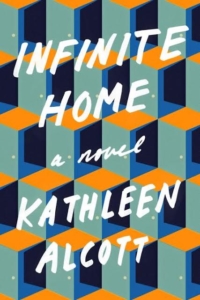Richard Yates once wrote that he was only interested in stories that are about the crushing of the human heart. But the human heart cannot be squashed with a single sentence. It takes paragraphs and pages to tether it down. It is the job of life, and great novels, to silence its pulse.
Kathleen Alcott’s Infinite Home wields such ambition. It opens with a portentous blaze in the city’s streets. The residents of a small building, the novel’s protagonists, gather outside to watch. “Nothing brings a community together like a good old fire,” one of them comments. Yet a trepidation that tragedy is contagious spreads through the crowd.
The building’s proprietress, Edith, prides herself on her taste in people. But after her husband dies, “she began widening the scope of her generosity, drawing leases to those she found unusual, or hurt, or in visible need of asylum.” Her building fills with a maudlin comedian, a paralyzed painter, an agoraphobic hoarder, and Paulie, who has Williams Syndrome, a neurodevelopmental disorder characterized by developmental delays, a cheerful demeanor, and cardiovascular problems.
But as the building decays — steps eroding, banisters slanting, and wallpaper pealing — so does Edith’s health. She begins to forget the names of those around her, flying into fits of fury and confusion. Absent her nuclear family, her tenants step in to provide succor.
While such solicitude might seem unbelievable in an urban environment, the strength of Alcott’s prose imbues the story with artful potency:
The structure of the building ensured that no sound was contained by the apartment that produced it: the three floors gave and received heavy-footed trips to the refrigerator and unsnoozed alarm clocks and the burst-and-woosh of bath faucets and late-night infomercials in a reliable cycle. Living with the proof of other people’s lone domestic movement had become a kind of comfort for the tenants, a telephone that didn’t require they speak into it, a letter that didn’t ask for a reply.
Alcott transforms the clamor of a cheaply built edifice into a locus of intimacy. In the city, there is no dearth of lonely and broken people; Alcott’s skill lies in fitting these fragments together.
Yet Infinite Home has no shortage of tragedy. As Edith declines, the narrative arches backwards into her past. We see her early romance with her husband, her daughter’s mysterious decamp, and discover a brutally Faulknerian childhood trauma. As the past and present narratives weave together, Alcott constructs a clever conceit that links past trauma with the present drama.
The novel’s central theme is family. Where Edith is lacking in nuclear family, her tenants become a caring brood. Reciprocating the attentiveness she has paid them over the years, they tend to her as kindred. Paulie plays cards with her, Adeleine records Edith’s remembrances, Thomas searches for her long missing daughter. The tenants become a sprawling, and often unwieldy, but sympathetic clan. Alcott nurtures these connections with nuance and poetry.
Happy families are impossible to come by; unhappy families are the subject of far too many novels; Alcott contributes to a growing literature of the non-traditional family. Akin to Vivian Gornick’s recent memoir The Odd Woman in the City, in which Gornick recalls her thirty-year relationship with her queer, fellow native of the Bronx. The relationship, which outlasted two marriages, husbands a greater intimacy than her legal family. Likewise, Alcott steps out of the 1950s uniform of the traditional family to explore a more complex and ultimately rewarding network of kinship.
But by no means is this a new inquiry. Innumerable authors have explored the origin of identity. Vladimir Nabokov, emigrating from Russia to Berlin to America to Switzerland, wrote for half a century about the impressions it made on him. Eliot investigated the nature of familial obligation in times of change and complexity. Alcott’s contribution is prioritizing adopted family in the construction and growth of one’s identity.
While some of the tenants’ challenges are a bit too well tailored to their foibles (as is the case with Adeline), Claudia’s relationship with her elder brother evokes genuine pathos. After their parents die, Claudia is tasked with caring for her mentally challenged older brother. After having a falling out with her husband over the decision, she starts an affair with one of her neighbors. The threat of eviction sets the three on a journey to Tennessee to find a rare swarm of synchronous fireflies, about which Paulie has been talking for years.
Paulie told them that the Photinus carolinus gathered once a year, that thousands of the males pulsed in glowing simultaneity competing for the attention of the females that lusted below, watching, hoping to chose the brightest mate.
Ultimately, this is the dream of Infinite Home: for the disparate and damaged tenants of Edith’s building to come together as a single synchronized family. While each of the residents has their deficiencies, it is as a multitude that they shine most brightly. Yet, this non-traditional family does not come about by happenstance. Edith spends decades of care and consideration building a family into her building. Forging a space for this new type of family is the work that Alcott takes on, and at which she artfully succeeds.
While the concept of a non-traditional family is not a novel concept, the artistry of Alcott’s writing and the pathos of her character make Infinite Home a compelling read. While the novel ends somewhat abruptly (especially for Paulie), the stitching together of these vivacious characters into a single moving narrative will ignite even a jaded reader. But don’t begin this novel if you’re not prepared to have your heart crushed.
This post may contain affiliate links.








